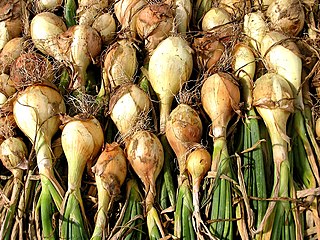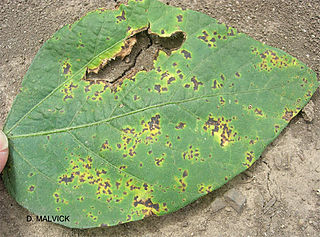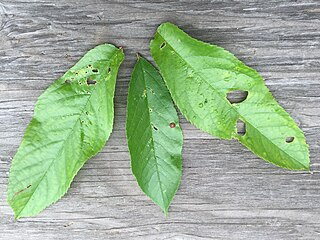
A leaf spot is a limited, discoloured, diseased area of a leaf that is caused by fungal, bacterial or viral plant diseases, or by injuries from nematodes, insects, environmental factors, toxicity or herbicides. These discoloured spots or lesions often have a centre of necrosis. Symptoms can overlap across causal agents, however differing signs and symptoms of certain pathogens can lead to the diagnosis of the type of leaf spot disease. Prolonged wet and humid conditions promote leaf spot disease and most pathogens are spread by wind, splashing rain or irrigation that carry the disease to other leaves.

White onion or Allium cepa are a cultivar of dry onion which have a distinct light and mild flavour profile. Much like red onions, they have a high sugar and low sulphur content, and thus have a relatively short shelf life. White onions are used in a variety of dishes, such as those of Mexican and European origin. Their uses in dishes often relate to their mild nature, they are often included in dishes to provide a light, fresh and sour taste to dishes and are often added uncooked to dishes such as salads.

Cercospora is a genus of ascomycete fungi. Most species have no known sexual stage, and when the sexual stage is identified, it is in the genus Mycosphaerella. Most species of this genus cause plant diseases, and form leaf spots. It is a relatively well-studied genus of fungi, but there are countless species not yet described, and there is still much to learn about the best-known members of the genus.
Glomerella graminicola is an economically important crop parasite affecting both wheat and maize where it causes the plant disease Anthracnose Leaf Blight.
Alternaria triticina is a fungal plant pathogen that causes leaf blight on wheat. A. triticina is responsible for the largest leaf blight issue in wheat and also causes disease in other major cereal grain crops. It was first identified in India in 1962 and still causes significant yield loss to wheat crops on the Indian subcontinent. The disease is caused by a fungal pathogen and causes necrotic leaf lesions and in severe cases shriveling of the leaves.

Gibberella zeae, also known by the name of its anamorph Fusarium graminearum, is a fungal plant pathogen which causes fusarium head blight (FHB), a devastating disease on wheat and barley. The pathogen is responsible for billions of dollars in economic losses worldwide each year. Infection causes shifts in the amino acid composition of wheat, resulting in shriveled kernels and contaminating the remaining grain with mycotoxins, mainly deoxynivalenol (DON), which inhibits protein biosynthesis; and zearalenone, an estrogenic mycotoxin. These toxins cause vomiting, liver damage, and reproductive defects in livestock, and are harmful to humans through contaminated food. Despite great efforts to find resistance genes against F. graminearum, no completely resistant variety is currently available. Research on the biology of F. graminearum is directed towards gaining insight into more details about the infection process and reveal weak spots in the life cycle of this pathogen to develop fungicides that can protect wheat from scab infection.
Cercospora arachidicola is a fungal ascomycete plant pathogen that causes early leaf spot of peanut. Peanuts originated in South America and are cultivated globally in warm, temperate and tropical regions.
Mycosphaerella cruenta, also called Pseudocercosopora cruenta in its asexual stage, is a fungal plant pathogen belonging to the group Ascomycota. It can affect several legume plants, including species of Phaseolus, Vigna, Calopogonium, Lablab niger, Mucuna and Stizolobium deeringianum [Mucuna pruriens][2]. It causes cowpea cercospora leaf spot, one of the most widespread and significant plant diseases in Africa and Asia. A city in China reported a 100% Mycosphaerella cruenta infection rate on cowpea in 2014[5]. In Africa, an epidemic can cause a yield loss of up to 40% [3].

Ascochyta pisi is a fungal plant pathogen that causes ascochyta blight on pea, causing lesions of stems, leaves, and pods. These same symptoms can also be caused by Ascochyta pinodes, and the two fungi are not easily distinguishable.

Cercospora sojina is a fungal plant pathogen which causes frogeye leaf spot of soybeans. Frog eye leaf spot is a major disease on soybeans in the southern U.S. and has recently started to expand into the northern U.S. where soybeans are grown. The disease is also found in other soybean production areas of the world.

Diaporthe phaseolorum var. sojae is a plant pathogen infecting soybean and peanut.

Cercospora melongenae is a fungal plant pathogen that causes leaf spot on eggplant. It is a deuteromycete fungus that is primarily confined to eggplant species. Some other host species are Solanum aethiopicum and Solanum incanum. This plant pathogen only attacks leaves of eggplants and not the fruit. It is fairly common among the fungi that infect community gardens and home gardens of eggplant. Generally speaking, Cercospora melongenae attacks all local varieties of eggplants, but is most severe on the Philippine eggplant and less parasitic on a Siamese variety.
This article summarizes different crops, what common fungal problems they have, and how fungicide should be used in order to mitigate damage and crop loss. This page also covers how specific fungal infections affect crops present in the United States.

Grey leaf spot (GLS) is a foliar fungal disease that affects maize, also known as corn. GLS is considered one of the most significant yield-limiting diseases of corn worldwide. There are two fungal pathogens that cause GLS: Cercospora zeae-maydis and Cercospora zeina. Symptoms seen on corn include leaf lesions, discoloration (chlorosis), and foliar blight. Distinct symptoms of GLS are rectangular, brown to gray necrotic lesions that run parallel to the leaf, spanning the spaces between the secondary leaf veins. The fungus survives in the debris of topsoil and infects healthy crops via asexual spores called conidia. Environmental conditions that best suit infection and growth include moist, humid, and warm climates. Poor airflow, low sunlight, overcrowding, improper soil nutrient and irrigation management, and poor soil drainage can all contribute to the propagation of the disease. Management techniques include crop resistance, crop rotation, residue management, use of fungicides, and weed control. The purpose of disease management is to prevent the amount of secondary disease cycles as well as to protect leaf area from damage prior to grain formation. Corn grey leaf spot is an important disease of corn production in the United States, economically significant throughout the Midwest and Mid-Atlantic regions. However, it is also prevalent in Africa, Central America, China, Europe, India, Mexico, the Philippines, northern South America, and Southeast Asia. The teleomorph of Cercospora zeae-maydis is assumed to be Mycosphaerella sp.

Ascochyta blights occur throughout the world and can be of significant economic importance. Three fungi contribute to the ascochyta blight disease complex of pea. Ascochyta pinodes causes Mycosphaerella blight. Ascochyta pinodella causes Ascochyta foot rot, and Ascochyta pisi causes Ascochyta blight and pod spot. Of the three fungi, Ascochyta pinodes is of the most importance. These diseases are conducive under wet and humid conditions and can cause a yield loss of up to fifty percent if left uncontrolled. The best method to control ascochyta blights of pea is to reduce the amount of primary inoculum through sanitation, crop-rotation, and altering the sowing date. Other methods—chemical control, biological control, and development of resistant varieties—may also be used to effectively control ascochyta diseases.

Southern corn leaf blight (SCLB) is a fungal disease of maize caused by the plant pathogen Bipolaris maydis.
Alternaria black spot of canola or grey leaf spot is an ascomycete fungal disease caused by a group of pathogens including: Alternaria brassicae, A. alternata and A. raphani. This pathogen is characterized by dark, sunken lesions of various size on all parts of the plant, including the leaves, stem, and pods. Its primary economic host is canola. In its early stages it only affects the plants slightly by reducing photosynthesis, however as the plant matures it can cause damage to the seeds and more, reducing oil yield as well.
Bacterial leaf streak (BLS), also known as black chaff, is a common bacterial disease of wheat. The disease is caused by the bacterial species Xanthomonas translucens pv. undulosa. The pathogen is found globally, but is a primary problem in the US in the lower mid-south and can reduce yields by up to 40 percent.[6] BLS is primarily seed-borne and survives in and on the seed, but may also survive in crop residue in the soil in the off-season. During the growing season, the bacteria may transfer from plant to plant by contact, but it is primarily spread by rain, wind and insect contact. The bacteria thrives in moist environments, and produces a cream to yellow bacterial ooze, which, when dry, appears light colored and scale-like, resulting in a streak on the leaves. The invasion of the head of wheat causes bands of necrotic tissue on the awns, which is called Black Chaff.[14] The disease is not easily managed, as there are no pesticides on the market for treatment of the infection. There are some resistant cultivars available, but no seed treatment exists. Some integrated pest management (IPM) techniques may be used to assist with preventing infection although, none will completely prevent the disease.[2]

Bacterial blight of soybean is a widespread disease of soybeans caused by Pseudomonas syringaepv. glycinea.

Shot hole disease is a serious fungal disease that creates BB-sized holes in leaves, rough areas on fruit, and concentric lesions on branches. The pathogen that causes shot hole disease is Wilsonomyces carpophilus.
2. Groenewald JZ, Nakashima C, Nishikawa J, Shin HD, Park JH, Jama AN, Groenewald M, Braun U, Crous PW (2013) Species concepts in Cercospora: spotting the weeds among the roses. Stud Mycol. 2013 Jun 30; 75(1): 115–170. Published online 2012 Oct 1. doi:10.3114/sim0012
























